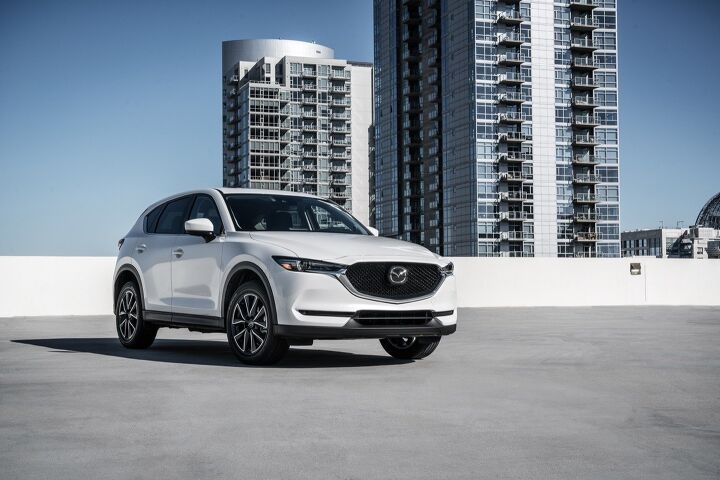A Curious Trim Level for New 2017 Mazda CX-5: Grand Select
Sitting just $500 below the top-spec 2017 Mazda CX-5 Grand Touring is a new Grand Select trim.
Mazda spokesperson Jacob Brown tells CarsDirect, which spotted the addition, that the 2017 CX-5 Grand Select is an attempt by Mazda USA to examine consumer tastes.
Grand Select, Brown says, “will be offered for a limited time and will test the waters for customer options preferences in the marketplace.”
Like the CX-5 Grand Touring, the $29,835 Grand Select is a very well-equipped, premium-aping compact crossover. Unlike the CX-5 Grand Touring, the Grand Select lacks forward collision warning, adaptive cruise, auto high beams, lane departure warning, and lane keeping assist. A few years down the increasingly autonomous road, those are the kinds of features that might be a real boon to resale.
Sure you wanna save $500?
The CX-5 Grand Select sneaks in under the $30K marker but still includes some advanced safety tech: blind spot monitoring and cross-traffic alert, for example. And because the Grand Select is essentially a CX-5 Grand Touring without a few enhanced safety features, there are still 19-inch wheels, leather seating, Bose audio, power driver’s seat, and a sunroof.
Although it’s increasingly normal for auto writers to hop in and out of vehicles with steering wheels that turn by themselves, cars that periodically brake whether you want them to or not, and cruise control that slows behind dawdling traffic, consumers who haven’t driven a new car since they bought their first CX-5 in 2012 can be in for quite a shock.
With the 2017 CX-5 Grand Select, Mazda will be able to determine whether some of the consumers who want luxury content would rather not encounter any form of autonomous driving.
If Mazda is going to perform such a test, the CX-5 is the volume vehicle with which to do so.
Although Mazda’s company-wide volume remains unimpressive in the United States, the CX-5 is on track for its best year ever in 2017, continuing an unending growth streak for what is now the most popular Mazda. The current pace pegs U.S. CX-5 sales at 125,000 units in 2017, a 57-percent jump compared with 2013, the nameplate’s first full year. On a monthly basis, CX-5 sales have grown, year-over-year, in 43 of the last 52 months. 40 percent of the Mazdas sold in the United States in the first five months of 2017 were CX-5s.
As for other CX-5s, the basic 2017 CX-5 Sport starts at $24,985, including a $940 destination fee. The mid-grade Touring is $26,855. The Grand Touring is $30,335. All-wheel drive is a $1,300 option at each level. There are no manual transmissions.
[Image: Mazda]
Timothy Cain is a contributing analyst at The Truth About Cars and Autofocus.ca and the founder and former editor of GoodCarBadCar.net. Follow on Twitter @timcaincars.
More by Timothy Cain
Latest Car Reviews
Read moreLatest Product Reviews
Read moreRecent Comments
- Jeff Self driving cars are not ready for prime time.
- Lichtronamo Watch as the non-us based automakers shift more production to Mexico in the future.
- 28-Cars-Later " Electrek recently dug around in Tesla’s online parts catalog and found that the windshield costs a whopping $1,900 to replace.To be fair, that’s around what a Mercedes S-Class or Rivian windshield costs, but the Tesla’s glass is unique because of its shape. It’s also worth noting that most insurance plans have glass replacement options that can make the repair a low- or zero-cost issue. "Now I understand why my insurance is so high despite no claims for years and about 7,500 annual miles between three cars.
- AMcA My theory is that that when the Big 3 gave away the store to the UAW in the last contract, there was a side deal in which the UAW promised to go after the non-organized transplant plants. Even the UAW understands that if the wage differential gets too high it's gonna kill the golden goose.
- MKizzy Why else does range matter? Because in the EV advocate's dream scenario of a post-ICE future, the average multi-car household will find itself with more EVs in their garages and driveways than places to plug them in or the capacity to charge then all at once without significant electrical upgrades. Unless each vehicle has enough range to allow for multiple days without plugging in, fighting over charging access in multi-EV households will be right up there with finances for causes of domestic strife.



































Comments
Join the conversation
I'm willing to bet that the discounted insurance premiums of the Grand Touring with the full package of aids and safety features will more than make up for the extra $500 over the course of a few years.
My insurance offers discounts for features like ABS, blind spot monitoring, back up cameras, and I'd presume others like lane holding and automatic braking. I was asked about those at the time of enrollment but I don't have those on my vehicles so I don't see that discount on my bill. At the very least I'd expect insurers to assess risk and resulting premiums not just on make and model but also trim level. One can reasonably hypothesize that buyer's of higher trim levels with more safety tech will make fewer claims. As it is, drivers of cheaper vehicles tend to be involved with more collisions than those driving newer and more expensive vehicles. Regarding the savings - if the average modern car buyer is financing for 60 months the insurance premium savings need only be $8/month to make up that additional expenditure on the higher trim level.